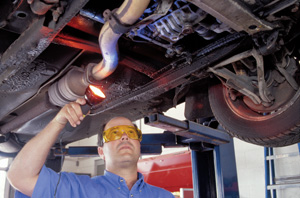The main concern with the exhaust system is leaks. Besides making a lot of noise, exhaust leaks can be dangerous because of the carbon monoxide it contains. Carbon monoxide fumes that enter the passenger compartment can cause people to get dizzy, sick, pass out or die!
 The exhaust manifold is bolted to the cylinder head and routes hot exhaust gases into the rest of the exhaust system. The manifold may be cast iron or welded stainless steel tubing. Manifolds run extremely hot and
The exhaust manifold is bolted to the cylinder head and routes hot exhaust gases into the rest of the exhaust system. The manifold may be cast iron or welded stainless steel tubing. Manifolds run extremely hot and
occasionally crack allowing exhaust gases and noise to leak into the engine compartment.
Aftermarket replacement exhaust manifolds are available for many engines. Related items that should also be replaced if changing a manifold include the exhaust manifold gasket and the manifold mounting bolts.
The exhaust manifold routes the exhaust into a head pipe. This pipe is usually made of stainless steel to resist high temperatures. The head pipe connects to the catalytic converter, but on some engines, the converter attaches directly to the manifold. On V6 and V8 engines with a single exhaust system, the head pipe is called a “Y-pipe” because it is shaped like a “Y” and joins the two sides together into a single outlet. On some import front-wheel drive cars with transverse-mounted engines, the head pipe has a ribbed flexible section covered by stainless steel webbing. This allows the pipe to flex as the engine rocks. After many miles, the flex section eventually cracks and starts to leak. Flexible head pipes are very expensive to replace, so there are flexible repair sections that can be welded into an existing pipe (requires professional installation).
Behind the head pipe is the catalytic converter (see the section on emission controls for additional details). There are four basic types: “Two-way” converters in pre-1980 vehicles that reduce unburned hydrocarbons (HC) and carbon monoxide (CO), “three-way (TWC)” converters in many 1980 and newer vehicles that reduce HC, CO and oxides of nitrogen (NOX), “three-way plus oxygen” converters in newer vehicles that have additional plumbing to accept air from an air pump to reduce HC, CO and NOX, and “OBD II” converters that are essentially three-way converters certified to meet OBD II requirements on 1996 and newer vehicles.
Behind the converter is usually an intermediate pipe or exhaust pipe that connects to a muffler or resonator. Mufflers contain tubes and baffles to reduce exhaust noise. Most original equipment mufflers are a three-tube design to provide maximum sound control. Resonators contain fewer tubes and baffles and are used primarily to “tune” the sound of the exhaust. Some vehicles use both, others use just a muffler.
Mufflers and resonators typically rust from the inside out. Exhaust contains corrosive acids and moisture. When the engine is shut off, moisture condenses and puddles in the muffler. Over time, the resulting corrosion can eat through the shell. Most late model vehicles now have mufflers made of long-lasting stainless steel. A few are even using lightweight titanium mufflers and pipes (Corvette, for example). But most aftermarket replacement mufflers are made of less expensive aluminized steel or coated steel. Stainless steel is available, but usually only in aftermarket performance mufflers.
Replacement mufflers are available in various price ranges. The best (and most expensive) are premium mufflers that provide superior sound control and corrosion resistance. These may have extra tubes and baffles, fiberglass “roving” for additional sound absorption, and a lifetime warranty. Next would be a standard replacement muffler, which is often a direct bolt-on replacement. There are also “universal” mufflers that can be installed on a wide variety of applications using pipe adapters, and low-cost “economy” mufflers for those who are mostly concerned with keeping their repair costs down.
Polished stainless steel performance mufflers and resonators are also available for many vehicles and are especially popular on sports compact cars these days. Many have “straight-thru” designs to reduce backpressure for more horsepower. “Turbo” style performance mufflers and other low-restriction designs are also popular upgrades for customers who want to uncork the exhaust.
Chrome and stainless steel exhaust tips are also popular these days. And the bigger the better. These bolt-on exhaust accessories are affordable and easy to install. They don’t really do much for performance, but they look “cool” and that’s what many young drivers want.
New clamps are almost always necessary when replacing an exhaust pipe or muffler. New hangars may also be needed if the old ones are broken or missing. Factory heat shields should be reused if they are still in good condition, or replaced if badly rusted, broken or missing.
DIY customers who are replacing their own pipes or mufflers may also require some special tools for exhaust work. This includes a pipe cutter and/or muffler chisel for removing or separating old pipe connections, and a pipe expander for installing new pipes and mufflers.











